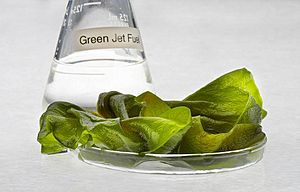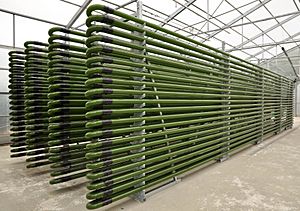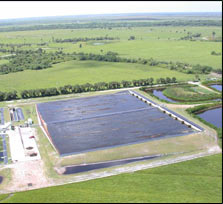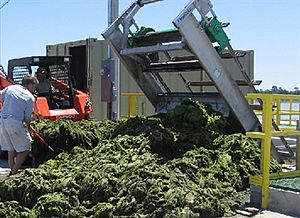Algae fuel facts for kids

Algae fuel, also called algal biofuel or algal oil, is a type of fuel that comes from algae. Algae are tiny plant-like organisms that can produce energy-rich oils. This fuel is an alternative to fossil fuels like gasoline and diesel. It's also different from other biofuels made from plants like corn or sugarcane. When it's made from seaweed (which is a type of large algae), it can be called seaweed fuel.
In December 2022, a big oil company called ExxonMobil stopped funding its research into algae biofuels. They were the last major oil company still investing in this area.
Contents
- How Algae Fuel Started
- Algae Oil in Food
- Types of Fuels from Algae
- Types of Algae Used
- What Algae Need to Grow
- How Algae are Grown
- Making Fuel from Algae
- Nutrients for Algae Growth
- Environmental Benefits
- Cost of Algae Fuel
- Using Byproducts
- Benefits of Algae Fuel
- Challenges of Algae Fuel
- International Policies
- See Also
- Images for kids
How Algae Fuel Started
In 1942, two scientists, Harder and Von Witsch, first suggested growing tiny algae called microalgae to get oils for food or fuel. After World War II, many countries like the US, Germany, and Japan started researching how to grow microalgae on a larger scale. They especially looked at a type of algae called Chlorella.
Later, in the 1970s, when oil prices went up, people became interested in algae for fuel again. The US Department of Energy started the Aquatic Species Program in 1978. They spent $25 million over 18 years to try and make liquid fuel from algae that could compete with regular oil.
This program focused on growing microalgae in large outdoor ponds. They collected 3,000 types of algae and looked for ones that grew fast, had lots of oil, and could handle different temperatures. A big discovery was that algae couldn't grow super fast and produce lots of oil at the same time. Fast growth needed many nutrients, but high oil production needed fewer. The program ended in 1996 because the cost of algae fuel was still too high compared to regular oil.
Even though the main program stopped, other research helped. For example, in the 1990s, Japan studied how algae could help capture carbon dioxide (CO2) from power plants. This showed that algae could grow using CO2 from factory smoke, which is important for making biofuel.
Interest in algae fuel grew again in the 2000s as oil prices rose. Many countries, including Australia, Europe, and the US, started funding new research projects. However, experts say that making biofuels widely available will need billions of dollars and many years to solve the natural challenges of growing algae for fuel.
Algae Oil in Food
Algae oil is also used as a healthy addition to food. It contains good fats called fatty acids, especially EPA and DHA, which are found in fish oil. The amount of DHA in algae oil is similar to what you find in salmon fish oil.
Types of Fuels from Algae
Algae can be turned into different kinds of fuels. This depends on how they are processed and which parts of the algae cells are used. The oily part of the algae can be taken out and made into biodiesel. This is similar to how other vegetable oils are used. It can also be refined into "drop-in" fuels that work just like regular petroleum fuels. The carbohydrate (sugar) part of algae can be fermented to make bioethanol or butanol fuel.
Biodiesel from Algae
Biodiesel is a fuel made from animal or plant oils and fats. Some types of algae can produce a lot of oil, sometimes more than 60% of their dry weight! Microalgae grow in water, so they can easily get water, CO2, and nutrients. This means they can produce a lot of biomass and useful oil. This oil can then be made into biodiesel for cars.
Algae grow much faster than land crops because they don't need to make strong stems or roots. They can also turn a much larger part of their body into oil. For example, algae can be 60% oil, while soybeans are only 2-3% oil. The amount of oil from algae per area is estimated to be 10 to 23 times higher than the next best crop, which is oil palm.
The US Department of Energy's Aquatic Species Program (1978–1996) focused on making biodiesel from microalgae. Their final report suggested that algae biodiesel might be the only way to produce enough fuel to replace all the diesel used in the world.
Biobutanol from Algae
Butanol can be made from algae or diatoms using a solar-powered biorefinery. This fuel has slightly less energy than gasoline but more than ethanol or methanol. Butanol can often be used in gasoline engines without changes. It can also give better performance when mixed with gasoline compared to ethanol.
The leftover green material after extracting oil from algae can be used to make butanol. Also, large algae (seaweeds) can be fermented by certain bacteria to produce butanol.
Some algae species being studied for ethanol or butanol production include:
- Alaria esculenta
- Laminaria saccharina
- Palmaria palmata
Biogasoline from Algae
Biogasoline is gasoline made from biomass. Just like regular gasoline, it has between 6 and 12 carbon atoms per molecule. It can be used in internal-combustion engines.
Biogas from Algae
Biogas is mostly made of methane (CH
4) and carbon dioxide (CO2). Seaweed can produce methane faster than land plants. Making biogas from seaweed is technically possible but often too expensive because of the cost of the seaweed itself. The carbohydrates and proteins in microalgae can be turned into biogas through a process called anaerobic digestion. This process works better when the algae has less than 40% oil.
Methane from Algae
Methane, the main part of natural gas, can be made from algae in different ways. These include gasification, pyrolysis, and anaerobic digestion. Anaerobic digestion is a simple method where microbes break down algae into smaller parts, then turn them into fatty acids. Finally, other microbes release a gas mixture that contains methane. This process can help recover energy from leftover algae biomass.
Ethanol from Algae
The Algenol system, used in Mexico, uses seawater and industrial exhaust to make ethanol. Another type of algae, Porphyridium cruentum, also shows promise for making ethanol because it can store a lot of carbohydrates.
Green Diesel from Algae
Algae can be used to make 'green diesel' through a refining process called hydrotreating. This process breaks down molecules into shorter chains, which are used in diesel engines. Green diesel has the same chemical properties as petroleum-based diesel. This means it can be used in existing engines, pipelines, and fuel systems without any changes. However, it's not yet cheap enough to compete with regular petroleum.
Jet Fuel from Algae
Airlines like Lufthansa and Virgin Atlantic tested using algae as biofuel as early as 2008. By 2015, scientists were researching if certain algae, like Isochrysis, could be a good source for jet biofuel.
Algae-Powered Devices
In May 2022, scientists at the University of Cambridge created a device that uses natural sunlight to power a small microprocessor with algae. This device, about the size of an AA battery, is a small container with water and blue-green algae. It doesn't make a lot of power, but it can be used for small devices like those in the Internet of Things. This could remove the need for traditional batteries and provide an eco-friendly power source in remote areas.
Types of Algae Used
Research for making oil from algae mostly focuses on microalgae. These are tiny organisms, less than 0.4 mm wide, that can perform photosynthesis. They include diatoms and cyanobacteria. Microalgae are preferred because they are simple, grow fast, and some types have a lot of oil. However, some research also looks at using larger seaweeds because they are very common.
As of 2012, researchers around the world were studying these algae species for oil production:
- Botryococcus braunii
- Chlorella
- Dunaliella tertiolecta
- Gracilaria
- Pleurochrysis carterae
- Sargassum (which can produce 10 times more than Gracilaria)
The amount of oil each type of algae produces varies a lot. Here are some examples of microalgae and their oil content by dry weight:
- Ankistrodesmus TR-87: 28–40%
- Botryococcus braunii: 29–75%
- Chlorella sp.: 29%
- Dunaliella tertiolecta: 36–42%
- Nannochloropsis: 46% (can range from 31–68%)
- Neochloris oleoabundans: 35–54%
- Schizochytrium: 50–77%
Ulva is also being studied because it grows very fast.
What Algae Need to Grow
Algae mainly need light to grow, as it's the most important factor. Many companies are working on ways to provide artificial light. Water temperature also affects how fast algae grow. Even small increases in water current can help algae grow faster by bringing more nutrients.
Besides light and water, algae also need nutrients like phosphorus, nitrogen, and other tiny amounts of minerals. Phosphorus is especially important for many of the algae's life processes. Studies have shown that phosphorus levels drop significantly when algae grow, meaning they use a lot of it.
There are special nutrient mixes, like Walne medium, used to grow algae in labs. But for growing large amounts of algae, cheaper, agriculture-grade fertilizers are used, focusing on the most important nutrients.
How Algae are Grown
Algae grow much faster than food crops. They can produce hundreds of times more oil per area than crops like rapeseed or soybeans. Since algae can be harvested every 1–10 days, you can get many harvests in a short time. Algae can also be grown on land that isn't good for regular crops, like dry land or salty soil. This means they don't compete with food farming. Most research focuses on growing algae in clean but expensive photobioreactors, or in cheaper open ponds that can get contaminated.
Closed-Loop Systems
Closed systems, which are not open to the air, prevent contamination from other organisms. A challenge for closed systems is finding a cheap source of clean CO2. Some experiments show that CO2 from factory smokestacks works well for growing algae. Many experts think that growing algae for fuel will need to be part of a larger system, like a power plant, where it can use waste heat and help clean up pollution.
Photobioreactors
Many companies growing algae for fuel use plastic or glass tubes called "bioreactors" (or photobioreactors, PBRs). These tubes are filled with nutrient-rich water and exposed to sunlight. Running a PBR is harder and more expensive than using an open pond. However, PBRs offer more control and can produce more algae. They can also be easily connected to other industrial systems.
Open Ponds
Open pond systems are simple ponds dug into the ground, often mixed by a paddle wheel. These systems are cheaper to build and run than closed photobioreactors. Most companies that produce high-value algae products use open pond systems.
Algae Turf Scrubbers
An Algae scrubber (ATS) is a system designed to clean nutrients and pollutants from water using algae. It works by taking nutrient-rich water from waste streams or natural sources and flowing it over a sloped surface. This surface has a rough material where natural algae can grow. Once the algae grow, they can be harvested every 5–15 days. This method can produce a lot of algae biomass. Unlike other methods that focus on one type of algae, ATS uses many different natural algae types. The algae from an ATS system usually have less oil, making them better for fuels like ethanol, methane, or butanol.
ATS systems have several benefits: they can produce more algae than open ponds, they have lower operating costs, and they avoid contamination issues because they use natural algae. The cost of producing energy with an ATS system is much lower than with a photobioreactor. Since ATS also cleans water, its main purpose can be water treatment, with biofuel production as an added bonus.
Making Fuel from Algae
After harvesting, the algae biomass goes through several steps to become fuel. These steps can change depending on the type of algae and the fuel desired. This process is still being researched because the cost of extracting the oil is often higher than the value of the oil itself. One idea is to use filter feeders (animals that eat algae) to help with harvesting. Another method is to grow algae with certain fungi, which makes the algae clump together for easier collection.
Drying and Extraction
Often, the algae are dried first. Then, a chemical like hexane is used to pull out the energy-rich oils, like triglycerides, from the dried algae. These extracted oils can then be turned into fuel using standard industrial methods. For example, triglycerides are mixed with methanol to create biodiesel. The type of fatty acids in the algae affects the quality of the biodiesel, so choosing the right algae species is important.
Hydrothermal Liquefaction
Another way to process algae is called Hydrothermal liquefaction. This is a continuous process where wet algae are heated to very high temperatures (350°C or 662°F) and pressures (3000 psi). This process creates crude oil, which can then be refined into aviation fuel, gasoline, or diesel. This method can turn 50 to 70 percent of the algae's carbon into fuel. It also produces clean water, fuel gas, and nutrients like nitrogen, phosphorus, and potassium.
Nutrients for Algae Growth
Nutrients like nitrogen (N), phosphorus (P), and potassium (K) are vital for plant growth and are found in fertilizers. Silica and iron, along with other trace elements, are also important for algae, as a lack of any of these can limit their growth.
Carbon Dioxide
Adding CO2 to algae growing systems can greatly increase how much algae they produce. About 1.8 tons of CO2 are used for every ton of dry algae produced. For example, a distillery in Scotland uses CO2 from making whisky to grow microalgae. Each ton of microalgae absorbs two tons of CO2. The algae are then sold as high-protein food for fish farms.
Nitrogen
Nitrogen is a useful nutrient for algae growth. Nitrate is the best source of nitrogen for growing a lot of algae. Urea is also a good and cheap option for large-scale algae farming. While nitrogen helps algae grow, changing nitrogen levels can also affect how much oil the algae produce. For instance, if algae don't get enough nitrogen for 72 hours, their total fatty acid content can increase significantly. This means the algae make new fats, which are stored as oils. Scientists are looking for ways to get both fast growth and high oil content.
Using Wastewater
Wastewater from sewage, farms, or floods can be a source of nutrients for algae. This water is usually a pollutant, but it can be used to feed algae. However, it needs to be treated by bacteria first. If not treated, it can contaminate the algae. In biogas facilities, organic waste is turned into a mix of CO2, methane, and liquid fertilizer. This liquid fertilizer is almost ready for algae growth but needs to be cleaned and sterilized.
Using wastewater or ocean water instead of fresh water is a good idea because fresh water is becoming scarce. But heavy metals and other pollutants in wastewater can harm the algae and reduce their ability to produce oils. The same is true for ocean water, though the pollutants are different. So, agricultural fertilizers are often preferred. However, heavy metals can still be a problem. Some types of algae can even remove over 90% of nickel and zinc from industrial wastewater quickly.
Environmental Benefits
Compared to land crops like corn, growing microalgae for fuel uses much less land. This is because microalgae produce a lot more oil per area. Algae can also grow on land that isn't good for regular crops, or in salty water that can't be used for farming or drinking. They can even grow on the ocean surface in special bags. This means algae could provide clean energy without affecting food or water supplies, or harming biodiversity.
Algae farming also doesn't need insecticides or herbicides, which means no pesticide waste. Algae biofuels are also less toxic and break down more easily than petroleum fuels. However, like any fuel, they are flammable, so there are still some environmental risks if they spill or catch fire. But these risks are lower than with fossil fuels because algae biofuels can be produced locally and are less toxic. So, they should still be handled safely, just like petroleum fuels.
Studies show that replacing fossil fuels with renewable energy sources like biofuels can reduce CO2 emissions by up to 80%. An algae system could capture about 80% of the CO2 from a power plant when there's sunlight. Even though this CO2 is released when the fuel burns, it would have entered the atmosphere anyway. The real benefit comes from preventing the CO2 from fossil fuels from being released. Also, compared to diesel and petroleum, and even other biofuels, making and burning algae fuel doesn't produce sulfur oxides or nitrous oxides. It also produces less carbon monoxide and other harmful pollutants. Since land plants can't produce enough biofuel to meet our energy needs, microalgae might be one of the only ways to fully replace fossil fuels.
Microalgae production can also use salty waste or waste CO2. This creates a new way to make biofuel while also treating wastewater and producing clean water. When algae are grown in a bioreactor, they capture organic compounds and heavy metals from wastewater that would otherwise pollute rivers and groundwater. This process also helps recover phosphorus, which is a rare but essential element. Algae turf scrubbers (ATS) can also clean up pollution from many sources, like farm runoff. They have been shown to reduce nitrogen and phosphorus in rivers and can process huge amounts of water daily. ATS can also treat pollution from specific sources, like wastewater or livestock waste.
Growing Different Types of Algae Together
Most research on algae biofuels has focused on growing only one type of algae (monocultures). However, studies show that growing many different types of plants or algae together (polycultures) often produces more yield than growing just one type. Experiments also show that diverse groups of aquatic microbes are more stable over time. Recent studies found that polycultures of microalgae produced significantly more oil. Polycultures are also more resistant to pests, diseases, and invasion by other plants or algae. So, growing different types of microalgae together might increase fuel yields, make them more stable, and reduce the environmental impact of the algae biofuel industry.
Cost of Algae Fuel
There's a clear need for sustainable biofuels, but whether a biofuel is used depends on its cost. So, research is focused on making algae biofuel cheap enough to compete with regular petroleum. Making several products from algae (not just fuel) is seen as the most important way to make algae production profitable. Other factors include improving how efficiently algae turn sunlight into biomass and making oil extraction easier.
In 2007, a formula was created to estimate the cost of algae oil needed to compete with petroleum diesel. It suggested that algae oil would need to be much cheaper than crude oil.
The International Energy Agency (IEA) estimates that algae biomass can be produced for as little as $0.54 per kilogram in warm climates using open ponds, or up to $10.20 per kilogram in cooler climates using photobioreactors. If the biomass contains 30% oil, the cost of biomass for one liter of oil would be about $1.40 for photobioreactors and $1.81 for open ponds. The final cost of oil from photobioreactors is estimated at $2.80 per liter, assuming oil recovery adds 50% to the cost. If algae projects can reach a biodiesel production price of less than $1 per gallon, the US might be able to replace 20% of its transport fuels with sustainable algae fuels by 2020.
However, the high upfront cost of building algae-to-biofuel facilities is a major challenge. Some studies suggest that algae oil would only be competitive if crude oil prices were very high, like $800 per barrel. Other studies found that photobioreactors are too expensive for making biofuels. Open ponds might be cost-effective in warm places with very low labor costs. Overall, capital costs, labor costs, and operational costs (like fertilizer and electricity) are currently too high for algae biofuels to compete with traditional fuels. Unless new, cheaper ways are found, the great potential of algae for biofuels might not be economically possible. In 2012, Rodrigo E. Teixeira showed a new process for harvesting and extracting raw materials from algae that uses much less energy.
Using Byproducts
Many byproducts from processing microalgae can be used in other ways. Some of these products, like natural dyes, pigments, and antioxidants, have been used for a long time. These chemicals and leftover algae biomass are used in many industries. For example, dyes and oils are used in cosmetics as thickeners. The pharmaceutical industry has found antibiotics and antifungals from microalgae, as well as natural health products. For instance, Spirulina contains healthy fats (Omega 3 and 6), amino acids, vitamins, and pigments like beta-carotene.
Benefits of Algae Fuel
Easy to Grow
One big advantage of using microalgae for fuel is how easily they can be grown. Algae can grow on land that isn't suitable for regular crops. Also, wastewater, which normally harms plants, can be very effective for growing algae. This means algae can be grown without using valuable farmland needed for food. Algae also need fewer resources and less attention, making their growth a simple process.
Less Impact on Food Supply
Many traditional biofuel sources, like corn and palm, are also used for animal feed and human food. Using them for fuel reduces the amount of food available, which can increase food and fuel prices. Using algae for biodiesel can help solve this. First, algae are not a main food source for humans, so using them for fuel won't affect the food industry much. Second, many waste products from processing algae for fuel can be used as good animal feed. This helps reduce waste and is cheaper than traditional corn- or grain-based feeds.
Reducing Waste and Pollution
Growing algae for biofuel also has many environmental benefits. It's a much greener option than current biofuels. For example, algae can use runoff water, which is contaminated with fertilizers from farms, as its main water and nutrient source. This stops polluted water from mixing with our drinking water in lakes and rivers. The ammonia, nitrates, and phosphates in this contaminated water, which are usually harmful, actually serve as excellent nutrients for the algae. This means fewer resources are needed to grow the algae. Many algae species used for biodiesel are great at absorbing carbon dioxide from the air. Because of this, they are used in industries to treat exhaust gases and reduce greenhouse gas emissions.
Challenges of Algae Fuel
High Water Needs
Growing microalgae needs a lot of water. Studies estimate that producing 1 liter of algae-based biodiesel requires between 607 and 1944 liters of water. However, wastewater and/or seawater, which also contain nutrients, can be used instead of fresh water.
Commercial Viability
Algae biodiesel is still a fairly new technology. Although research started over 30 years ago, it was paused in the mid-1990s due to lack of funding and low oil prices. Interest in algae biofuels only revived in the early 2000s when gas prices went up.
Since 2017, there has been more interest in seaweed farming for carbon capture, reducing water pollution, and food production. This has led to commercial seaweed farms. As the cost of growing and harvesting seaweed goes down, and as the industry grows, the economics of macroalgae biofuels will improve. Climate change has also caused large mats of brown seaweed to wash up on Caribbean shores. Currently, these mats are thrown away, but there's interest in using them to make biofuel.
Stability Issues
Biodiesel made from microalgae has a higher content of polyunsaturated fats compared to other biodiesels. While these fats help the fuel stay liquid in colder temperatures, they can also make the fuel less stable at regular seasonal temperatures.
International Policies
Canada
Since the 1975 oil crisis, many policies have been put in place in Canada, the US, and Europe to promote renewable fuels. In Canada, taxes were removed from propane and natural gas, and later from ethanol and methanol made from biomass. In 2006, the federal government announced a renewable fuels strategy. This plan aimed to increase the availability of renewable fuels, support Canadian production, help farmers, and speed up new technologies. Canadian provinces quickly followed:
- British Columbia (BC) required 5% ethanol and 5% renewable diesel by January 2010. It also set low carbon fuel requirements for 2012 to 2020.
- Alberta required 5% ethanol and 2% renewable diesel by April 2011. It also required renewable fuels to reduce greenhouse gas emissions by at least 25%.
- Saskatchewan required 2% renewable diesel in 2009.
In 2006, the Canadian Federal Government also promised to use its buying power to support the biofuel industry. A law stated that 75% of all federal vehicles should be motor vehicles when it's affordable.
United States
In the United States, policies have included discussing reducing government support for the oil industry. This support is usually much more than what is set aside for the biofuel industry. At the G20 meeting in Pittsburgh, leaders agreed that "inefficient fossil fuel subsidies encourage wasteful consumption, reduce our energy security, impede investment in clean sources and undermine efforts to deal with the threat of climate change." If these subsidies are removed, it would create a fairer market for algae biofuels to compete.
In 2010, the U.S. House of Representatives passed a law to give algae-based biofuels the same tax credits as cellulose biofuels. This law aimed to give algae biofuel projects a $1.01 per gallon production tax credit. The U.S. Government also introduced the Domestic Fuel for Enhancing National Security Act in 2011. This policy allows the Department of Defense (DOD) to enter into longer contracts (up to 15 years) for buying advanced biofuels, instead of the usual 5-year limit.
Other Countries
The European Union (EU) has also increased credits for second-generation algae biofuels. This was done by changing their Biofuels and Fuel Quality Directives.
See Also
Images for kids






